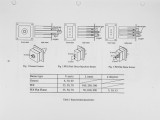| OCR Text |
Show radiative heat flux with luminous flame. Total radiative heat flux was especially high near the burner region. High soot concentration of luminous flame improved total radiative heat flux. Lower V also resulted in low flame stability, the flame sometimes bent toward the ceiling by buoyancy and damaged the fiber blocks. The lowest V was limited by flame stability and was 8 m/s in this experiment. Figure 8 shows the effect of V on NOx emission. Three levels of V (8, 30 and 60 m/s) were tested. Higher V resulted in lower N O x emission. Even at the highest V (60 m/s), the N O x emission level was as high as about 400 p p m (estimated N O x emission equivalent to air-fuel combustion is 48 ppm). Higher V promotes the self-induced exhaust gas recirculation of combustion products, thereby reducing peak flame temperature. The peak flame temperature is expected to drop drastically by the entrainment of the self-induced exhaust gas since the temperature of the entrained self-induced exhaust gas is much lower than the flame temperature and presumably close to flue gas temperature, higher level of self-induced E G R results in substantial temperature decrease and less N O x emission. Lower V leads to slower mixing between natural gas and oxygen and lower entrainment of self-induced recirculation, thereby creating high peak flame temperature with long flame. The high peak flame temperature and long residence time increased N O x emission. While the furnace temperature was kept at 1673 K in the experiments, it may be higher in practical glass melters, up to 1873 K. The temperature difference between 1673 and 1873 K shows a great effect on the formation of thermal NOx . Contrary to the result of this experiment, N O x emission may increase by the promotion of self-induced exhaust gas recirculation if the furnace temperature is higher than 1873 K. The effect of self-induced exhaust gas recirculation and furnace temperature on N O x emission will be examined by using mathematical modeling. The nitrogen contained in the glass batch is one of the major sources of N O x in the glass melter and the effects of this nitrogen on N O x emission will be examined in fields test in the future. Figure 9 shows the effect of nitrogen content in the oxidant on NOx emission. Higher nitrogen content in the oxidant resulted in higher N O x emission in all the cases. Higher V resulted in lower N O x emission at the same nitrogen content in the oxidant. With 5% nitrogen in the oxidant which is typically for the P S A generated oxygen, N O x emission was 800 p p m (estimated N O x emission equivalent to air fuel combustion is 96 ppm) at V=60 m/s and 1800 p p m (estimated N O x emission equivalent to air fuel combustion is 216 ppm) at V = 8 m/s. Typical N O x emission from conventional air-fuel fired regenerative 7 |


























